Samsung CU7000 Reviewed at $399.00 (55")
Product Name: Samsung CU7000
Product Description: 2023 Crystal UHD 4K TV
-
Design - 9/10
9/10
-
Image Quality - 8/10
8/10
-
Ports & Connectivity - 8.5/10
8.5/10
-
OS, Apps and Features - 9/10
9/10
-
Price / Quality - 8.8/10
8.8/10
Summary
Reviewed at $399.00 (55″)
Pros
- Good upscaling capabilities
- Extremely low input lag
- Tizen functionality
- Low price
Cons
- Very low SDR and HDR brightness
- Not very accurate image
- Audio is only for casual use
- Missing a lot of features
Cheapest Places to Buy :
*We are a reader-supported website. When you buy through links on our site, we may earn a small affiliate commission at no extra cost to you. Home Media Entertainment does not accept money for reviews.*
We recently started looking at many of Samsung‘s new releases and we already looked at some of their top offerings like the Samsung S95C and the Samsung QN90C. Today on the other hand, on our Samsung CU7000 review we will jump to the bottom of the performance ladder and test their most affordable 4K UHD TV they have on offer for this year.
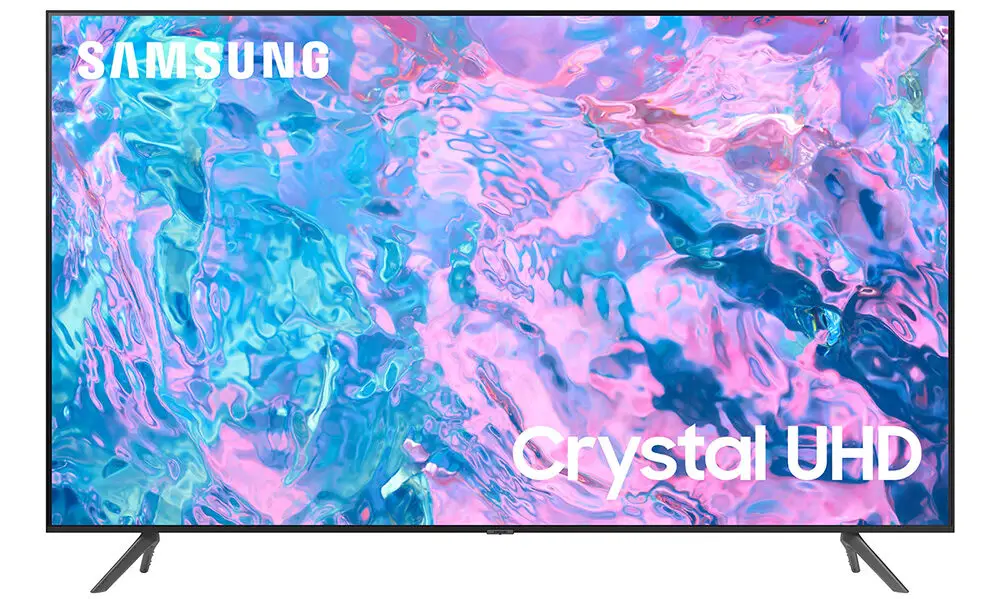
The CU7000 belongs in Samsung’s budget friendly Crystal series. Even with the arrival of QD-OLED the Korean manufacturer decided to keep the Crystal TVs around as an ultra cheap solution for those looking for a very low cost TV to get the job done. And having kept this series for several years now shows that this series has still some serious market strength behind it.
The CU7000 is not all that different from many other Crystal TVs before it. What we get is an Edge LED light system with a VA panel and a 60Hz frequency. For processing we find the Crystal Processor 4K while for sound there is Samsung’s OTS Lite. The TV supports HDR10+ and lastly the new 2023 Tizen, but with reduced capabilities. The TV is limited to HDMI 2.0 only while it retains its slim design and the new One Remote.
The CU7000 is replacing the 2021 AU7000 as there was no BU7000 last year. Unfortunately since we didn’t test that one we cannot do a direct comparison between the two. But since we did test the 2021 AU8000 we do have some reference to look at. Did Samsung improve anything in their latest affordable series or do we get more of the same as the previous years? Let’s start our analysis to find out.
Design
As always we will start with the design. The CU7000, being a low cost unit comes with a rather simple but yet effective design. It is different compared to previous Crystal TVs we had tested but the differences are as always subtle.
Measurements
The TV uses Samsung’s Slim Look Design making it look good enough for its price category. It may not be as slim as their Neo QLED or QD-OLED releases but honestly it cannot compare with them. As for this one we measured the panel 2.2″ (5.6 cm). This thickness is more or less what you should expect.
As for its black borders, these are the same ones we measured in our QN90C review. They are thin enough and do not bother when looking at the screen.
Back Side
The back side is also different from most other Samsung TVs we saw before. Being a Samsung we naturally get a plastic back panel with a brushed texture look on it. All ports are grouped together in an inset that is placed at the left side and all look sideways. This way you can reach them easier if you have it on a wall.
This is one of the rare cases where we find the power port placed right above the rest of the connectors. Usually the power port is placed on the other side, so it is a change we were not expecting.
On the lower part of the panel we get special grooves in order to place your cables and drive them through the bench type stand legs. There is no other noteworthy cable management system. The VESA wall mount holes is the only other element visible at the back.
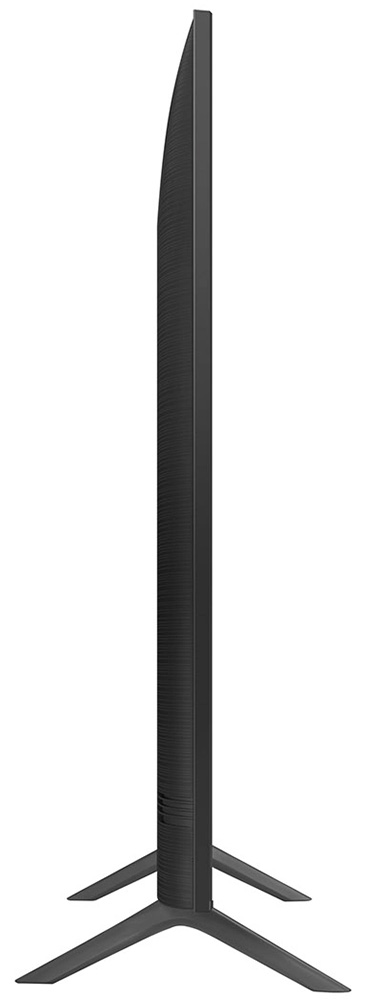
Stand
As for the stand, this is the standard bench type design that we see in many low cost releases. The legs slide into the bottom of the TV and do not need any screwing, which is great and trouble free. This bench type stand surely keeps the TV a bit more stable but on the other hand it needs a bigger surface to stand on.
The legs are made of plastic, which was to be expected, and you can use special clips at the back to drive the cables away from the TV.
As for the stand’s clearance, we measured it about 3.2″ which is more than enough for the majority of soundbars out there. But there are still a few models that may have problems with placement. So make sure to measure beforehand just to be safe.
Remote
As for the remote, the one you will get with the CU7000 is the same one we found in some 2021 Crystal TVs. Since this TV lacks certain functions it couldn’t use the exact same remote we found in some higher tier models.
Its design is the same as the 2021 version with the more premium look but on the other hand this one is missing voice control and the microphone. It also uses disposable batteries instead of a rechargeable one with the solar panel that we find in some other units.

In terms of functionality there is not much to say. This is the same One Remote we are used to for many years. Yes, there are many variations of it but fundamentally this is the same remote. A few differences in design or some different buttons do not make a significant change.
Overall the CU7000 has decent quality for its price. It will not wow you, but surely it doesn’t disappoint either.
Video Quality
Processor technology used
When it comes to processing the Crystal series continues to use the Crystal Processor 4K. We do not know if this exactly the same processor from previous years as Samsung never gives a lot of details on these chips. But looking at its capabilities we are fairly certain it is the same one.
The Crystal Processor 4K lacks the AI capabilities we see in the higher-tier processors and instead relies on very basic functionality. It is still a decent chip but without the bells and whistles of its more expensive brothers.
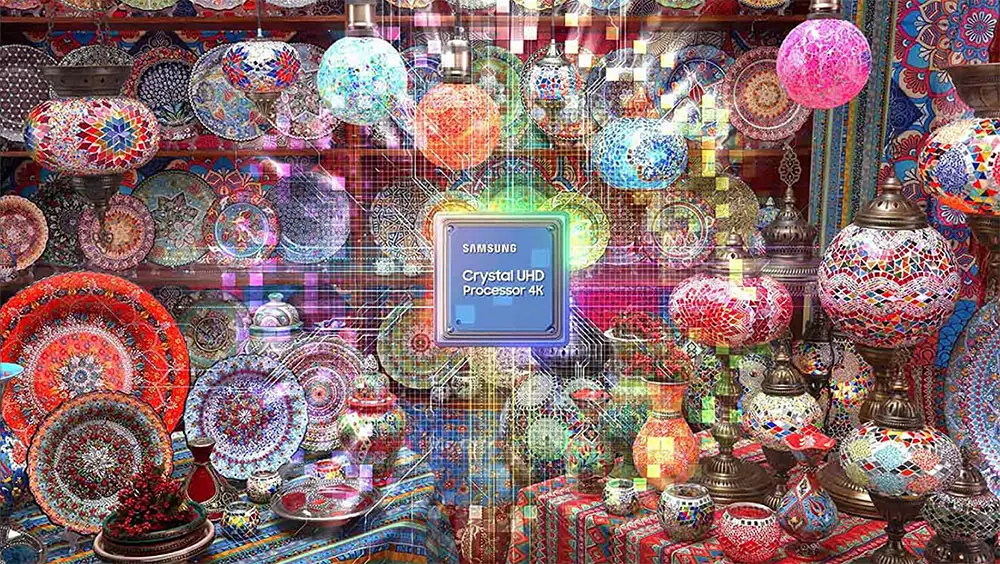
Resolution and Up-scaling
To test its up-scaling capabilities we playback a few different videos in various resolutions and quality. These include low quality compressed streaming videos, 480p DVDs, some 720p content and obviously some in 1080p resolution.
We couldn’t see any abnormal behavior and everything upscaled to 4K nicely. So in that respect the TV did very good.
Audio Processing
Obviously, with the Crystal Processor we find some reductions in the audio features compared to the more expensive releases. We do, once again, get Adaptive Sound while we find the OTS Lite audio system along with Q-Symphony. But more on these a bit further down in their dedicated section.
Lighting technology used
When it comes to its backlight system the Crystal series was always getting the short end of the stick. This means that it uses an Edge LED system without local dimming. Now for those that don’t know what an Edge LED system is, the TV is using LEDs usually are at the top and bottom of the panel to light the pixels on the screen.
This has some obvious disadvantages. One of them is that when you have a very dark background and a small bright object at the front, light stripes appear on screen. This obviously lowers the overall image quality.
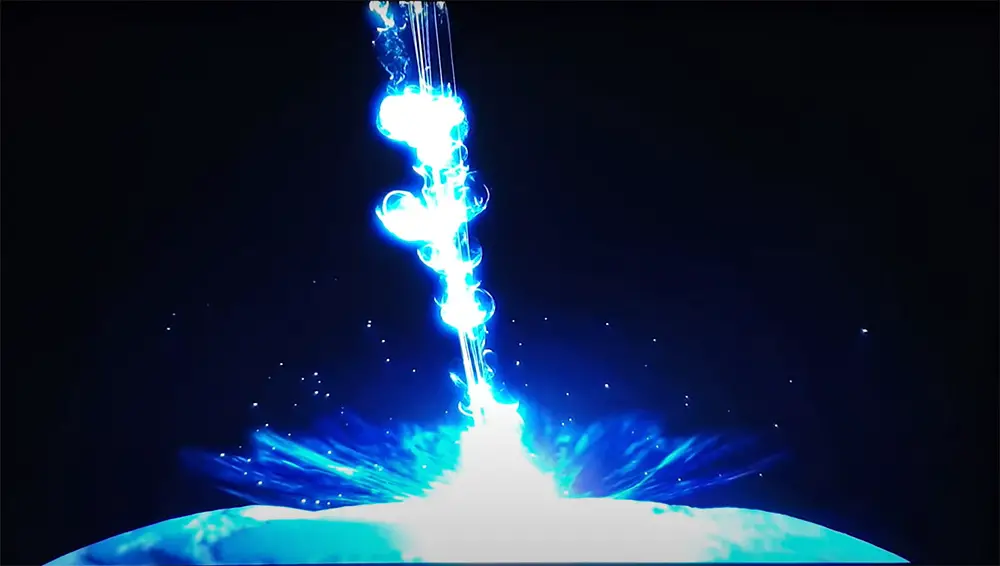
Another problem is that light control and precision is vastly lower. This has a detrimental effect on the final image quality. As there is no local dimming the TV cannot adjust the brightness of individual zones. This can result in a very washed out image when content asks for very bright highlights in specific scenes.
The obvious advantages of this system is that it can be used in cheaper models due to its lower cost. Also the overall thickness of Edge LED TVs is usually smaller than those utilizing a FALD system. This makes them ideal for wall mounting.
Number of Dimming Zones
As the TV is using an Edge LED system with no local dimming there are no LED zones behind the panel to light individually.
Blooming & Zones Transitioning
And this means that there is no zone transitioning. The TV cannot light specific areas of the screen when there is a highlight visible.
No local dimming means that there is no obvious blooming that most FALD and mini LED systems are plagued with. But on the other hand, in similar scenes, the whole screen feels washed out and less than ideal.
Brightness / Contrast
Next we will be looking at the brightness of the unit. In terms of settings we used the usual as we do in most Samsung models. We used the Movie mode and Warm 2 color tone along with Brightness set to High.

SDR and HDR Measurements
We start with our SDR brightness over a 10% window and the number we got was 257 nits. SDR content may not need excessive brightness but the TV is simply too dim even for that.
We then switched to HDR content and in our HDR brightness over a 10% window test we measured 265 nits. If for SDR content the TV’s brightness was average for HDR is simply bad.
Highlights have no pop and everything feels very dim and uninspiring. And you should also take into consideration that extremely small highlights will simply force the TV to ignore them. This will result in dimming the image even further, missing much desired details.
Automatic Brightness Limiter (ABL)
As with most TVs nowadays the CU7000 comes with an Automatic Brightness Limiter (ABL). This system lowers the overall brightness of the screen when large parts of it become very bright for a long period of time. This may not be very obvious when watching a movie for example. But it can be noticed more with bright static images, or if you use the TV as a computer monitor.
What we noticed was that with SDR content the ABL is not as aggressive as with HDR content. It is still there but more subtle. With HDR on the other hand it can be more obvious, if you look for it.

Last Year Comparison
Unfortunately since the CU7000 is not replacing any model from 2022 its direct predecessor comes from 2021. And more specifically the AU7000 which we didn’t have the chance of testing.
But we can compare it to the AU8000. And our brightness measurements indicate that the CU7000 performed similar to previous years.
EOTF Tracking
What was surprising was that the brightness levels followed the EOTF reference values extremely close up to its roll-off point. Obviously with so limited brightness capabilities this point is extremely low. And the TV naturally will clip everything above it, meaning you will lose some fine details. But till that point the TV displayed HDR brightness with noteworthy accuracy.
The only misstep we notice here is a small bump in the near black levels but the rest of the chart was great.
Contrast Performance
In terms of contrast the CU7000 comes with a VA panel. Usually VA panels tend to have good contrast ratios and the CU7000 is no different showcasing pretty deep blacks.
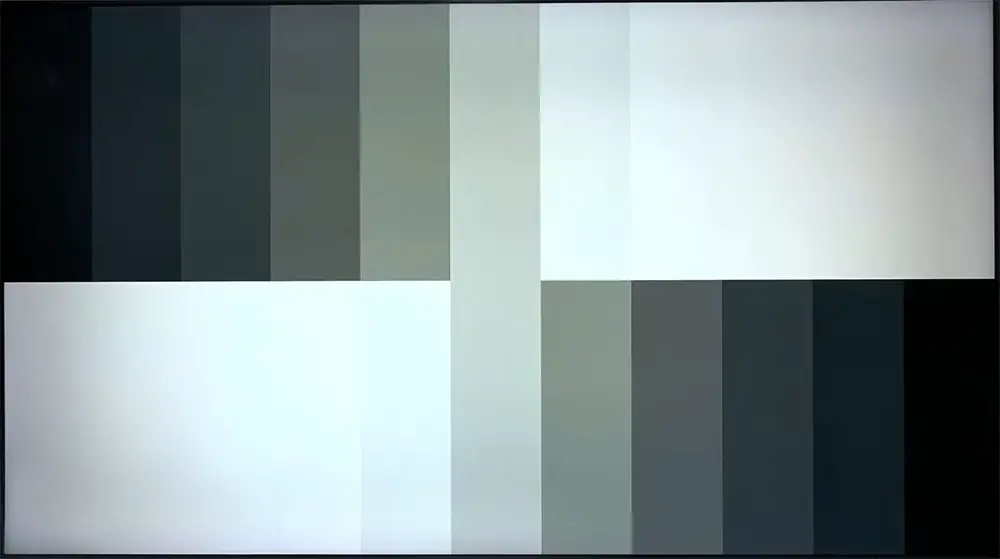
Unfortunately there is no local dimming here. Usually this helps with contrast even further but this is not the problem with the CU7000. The problem is that without it when there is a bright highlight the whole image will look washed out.
This happens because the TV cannot handle brightness in specific parts of the screen. Instead it has to raise the brightness on the entire panel, which creates this washed out look.
Viewing angles
The CU7000 comes with a VA panel and these in general don’t have very good viewing angles. In essence the TV performs similar to all other Crystal TVs that come with VA panels.
The 4K QLEDs series are also using VA panels but Samsung includes in some of them a special layer they call Ultra Viewing Angle. This way they improve the viewing angles at the expense of slightly less contrast.
Unfortunately the Crystal series doesn’t get this resulting in a very narrow field where it can keep it’s image integrity at acceptable levels. We would say that 25 degrees with an absolute maximum of 30 degrees is the most this TV can do. Anything more and image colors, black levels and brightness downgrade rapidly.
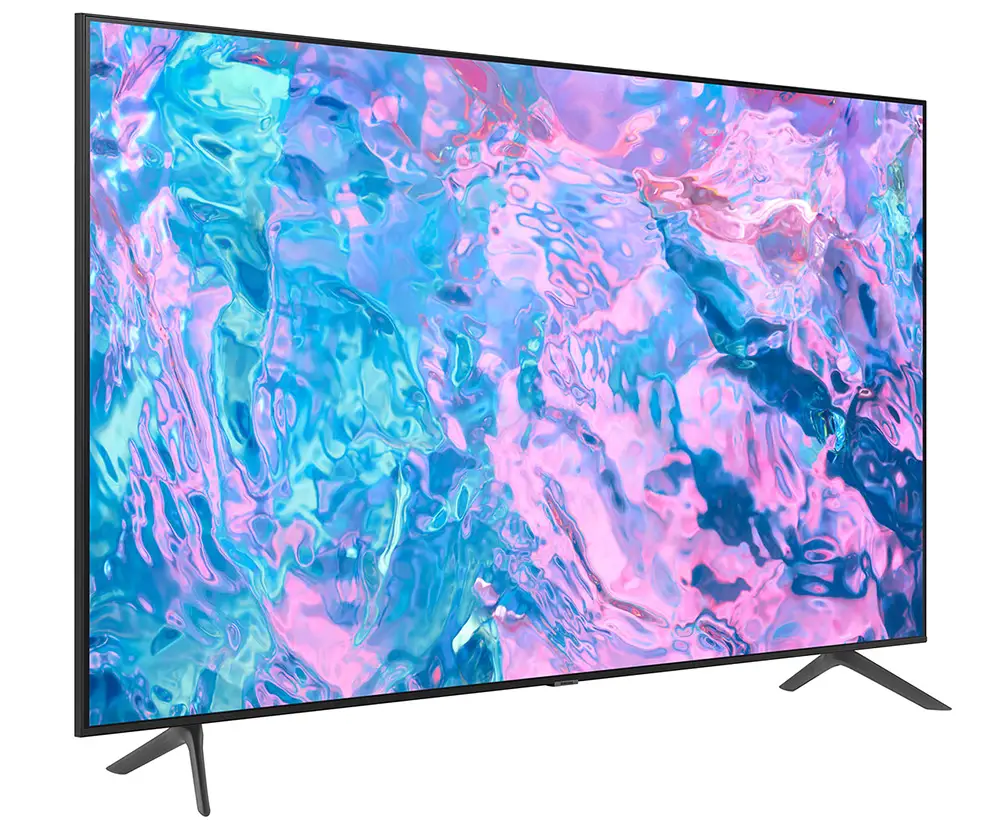
If you have a sweet spot from where you will be watching then this is not a big problem but if you plan to use this one in a family room then we would strongly suggest you try it out first before purchase.
HDR support
Although with such limited HDR brightness what HDR protocols the TV supports is a bit irrelevant, nevertheless Samsung included the usual.
We get the most basic HDR10 that is required for 4K UHD playback. There is also HLG that is used mainly for broadcasting. And lastly the newer HDR10+ which is the most advanced HDR protocol. This uses dynamic metadata in order to provide the best image quality on a frame by frame basis, similar to what Dolby Vision is doing.
The TV is missing some of the more advanced HDR features like HDR10+ Gaming, HDR10+ Adaptive and HDR Tone Mapping. These are only available in the higher tier models but this was to be expected.
Unfortunately, Samsung still refuses to allow Dolby Vision in their TVs and stay firm behind their own HDR10+. A big disappointment, and we have no hope this will change any time soon. But to be honest this wouldn’t make much of a difference to the CU7000. Its capabilities are extremely low to have any real impact anyway.

Color coverage
The Crystal series is losing Samsung’s Quantum Dot technology and instead it settles with the lower performing PurColor. PurColor displays focus on both primary and secondary colors to deliver a more natural, detailed image at a lower cost compared to the other display technologies.
As for the CU7000 specifically we measured its DCI-P3 coverage at 78%. In the wider REC.2020 the TV can cover approximately 58%. These numbers are ok for this price range. You cannot really have high expectations here, especially with Samsung models. So these numbers are more or less what we expected.
DeltaE Errors
Before calibration the TV could not display colors very accurate. There were problems all across the board and definitely it cannot offer an accurate image without any calibration. White balance was off, gamma was way lower than it should and many colors had DeltaE errors above 5.
Post calibration accuracy was way better. We managed to lower the DeltaE errors almost to the 3 threshold. Gamma increased to almost 2.1 while white balance approached its reference target.
But even with our calibration we cannot say that the TV is very accurate. There were some inconsistences that we could not fix. Specifically some colors were still a bit off but we could not bring them to the same level as the rest.

Color Gradients
Color gradients were ok with some of them showing visible banding especially in their darker shades. The reds for example did show visible banding in most scenes we tried.
There is also a Noise Reduction function in case you do see it. But if you enable it expect some detail to be lost. In general this is a feature we don’t like very much to use.
Motion performance
Next is our motion performance tests.
The CU7000 comes with a 60Hz panel along with a backlight dimming frequency of 480Hz. This is practically the same as many other Crystal TVs, so no surprises here.
Keep in mind that in certain picture modes we did see some flickering but this was not always the case. In Game mode we noticed it but it really depends on the settings. One such setting was the brightness level, which seemed to affect that to a certain degree. But there is no clear indication when this was happening.
When using the TV without any motion interpolation we did notice some judder in our motion tests which can be really bothering. And the only way to combat that was with motion interpolation that the TV comes with.
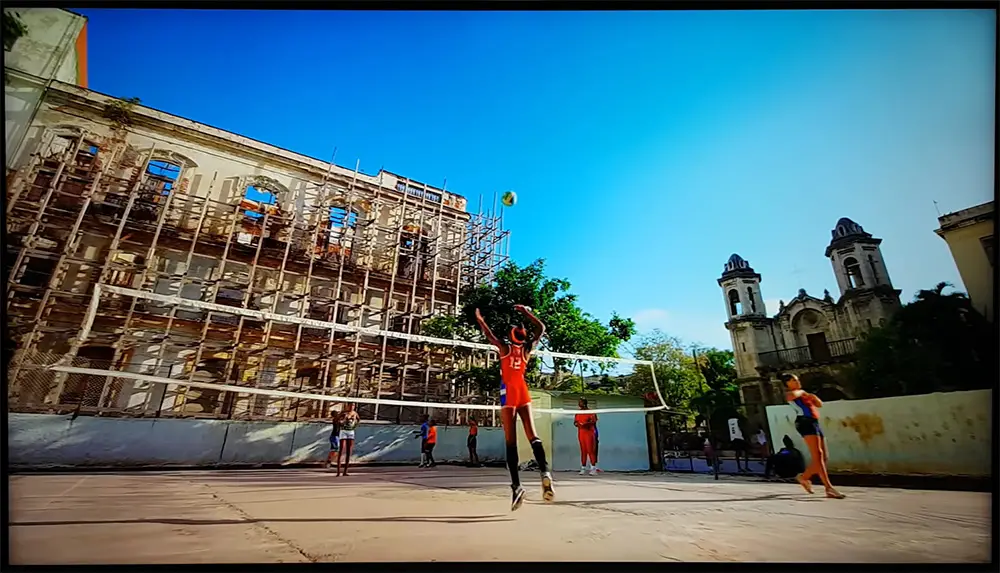
Motion Interpolation
Motion interpolation comes in the form of Motion Xcelerator. The CU7000 can remove judder from low frame rate content, up to 60fps. So for 24p content it has no trouble smoothing the motion. But as usual, when there is crazy action with a lot of fast camera movements there are a lot of artifacts appearing.
Stutter was also noticeable during low frame rate content which could only be eliminated by enabling motion interpolation.
This is enabled in the same way as with all other Samsung models. You will find it in the Picture Clarity settings, in the menu, and by adjusting the slider for judder. Keep in mind that very high values in this slider and the “Soap Opera Effect” will appear. So if you want to improve motion keep a low value. A setting of 1 or 2 can smooth motion enough without affecting the quality much.
Black Frame Insertion (BFI)
Black Frame Insertion (BFI) is also available and can be enabled in the menu with the LED Clear Motion option. BFI is a technique that inserts a black frame in between two individual frames in order to smooth out motion.
BFI in the CU7000 is a mixed bag. It does smooth motion but not without some undesirable side effects. With it enabled we noticed crosstalk and image duplication in some picture modes.

Another downside is that brightness takes a visible hit. And lastly due to the lower frequency used some flickering may become noticeable.
Overall Motion Impressions
To be honest the CU7000 did not show any major differences to previous Crystal TVs that we had tested. If you are a motion performance freak then this TV is surely not for you. It simply doesn’t have the capabilities to handle motion in a very advanced way.
But if you are not so much into details, and you need a TV for casual use, then surely it will cover all your basic needs.
Input lag Measurements
Let’s test the TV’s input lag output next.
According to our measurements the TV displayed an average of 11.5ms input lag in both 1080p and 4K resolutions at 60Hz. There is no support for 120Hz so this is the best you get.
We took both measurements after we obviously switched to Game mode. What is surprising is that the TV also measured low on input lag even outside Game mode. We measured this at 36.5ms which in comparison to other high tier releases is amazing.

This is a similar behavior to the Samsung AU8000, as that model also had extremely low input lag outside Game mode. This probably has to do with the fact that these TVs do very little image processing. And this is why we get so low numbers.
Other Gaming Features
The TV may not have many gaming centric features but it does support Auto Low Latency Mode (ALLM). And both the PS5 and Xbox consoles support this feature, so the TV will switch to Game mode automatically.
On the other hand there is no HGiG Mode available here.
VRR Support
The TV is also missing any variable refresh rate support.
On the other hand we do get Samsung’s Game Hub. With it you can use various online gaming services, including the Samsung-exclusive Xbox app. But as always the kind of content you will find in the Hub depends on the region you are.
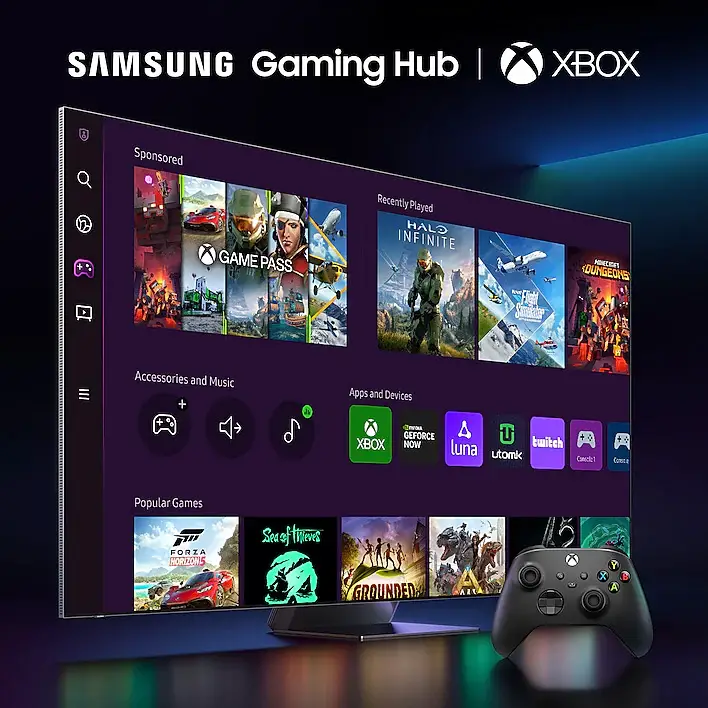
Trying Out a Few Games
As we usually do, to get a feel of the TV’s responsiveness we connected both our PS5 and Xbox series X. As for the game of choice, we went with Call of Duty: Modern Warfare 2 in 60Hz mode. With Game mode enabled the TV showcased very fast response times. We didn’t notice any abnormalities and all our commands registered on screen very fast.
We even tried some gaming outside Game mode and although we could sense the difference, it was still very much playable. Depending the game you play it may take you some time to get used to the different timings. But in total the TV can do great with 60fps games. Nothing major to complain about here.
Overall Image Quality Impressions
We have to be honest here. You cannot expect to buy such a low priced TV and expect to perform like a $2,000 model. Samsung showed us what their Crystal series is all about some time ago. And this doesn’t seem to have changed in 2023.
The CU7000 is average almost across the board. If you just want a 4K TV that gets the job done you will fully enjoy it. But if you start looking for all its problems then prepare yourself for a bad experience.
Its strong points are surely its stellar 4K up-scaling capabilities, its post-calibration color accuracy and very low input lag. These make the CU7000 an excellent low cost TV for casual gaming.
On the other hand its brightness, viewing angles, color coverage and motion performance were less than stellar.
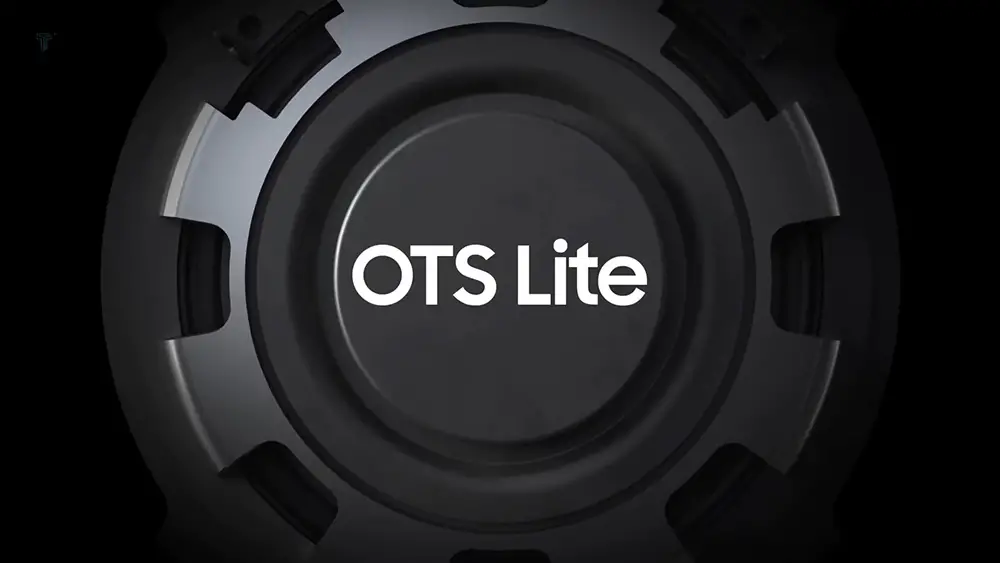
Audio Quality
As most brands, Samsung developed their own audio system to use in most of their new TV releases. It is called Object Tracking Sound and as of 2021 there are four variants of this system depending how capable it is. We have the OTS Pro, OTS+, OTS and OTS Lite.
The CU7000 got the Object Tracking Sound Lite (OTS Lite) variant, which seems to be the standard in many Crystal TVs now.
Audio System – Channels & Power Rating
The Object Tracking Sound Lite (OTS Lite) uses a 2.0 channels configuration and 20 watts of power output.
What we basically have here is two dedicated speakers at the bottom of the TV that work in parallel with virtual tech in order to create phantom speakers at the top of the panel.
The end result is not all that different. We tested much more advanced audio systems and even these couldn’t create a really immersive atmosphere. So the OTS Lite can do nothing more than offer a very basic output. And this is the best you should expect from this one.

Audio Formats Support
The TV supports Dolby Audio but there is no native Dolby Atmos. At least you can pass-through Dolby Atmos through the included eARC to some Dolby Atmos soundbar or dedicated sound system.
Once again there is no DTS support. As such, the TV cannot decode or pass-through DTS audio signals to another device. Samsung made that decision some years ago and seems to be definite.
If you really want DTS then Sony is the only of the big three that still supports it in their new releases, so keep that in mind.
Audio Features
Surprisingly the TV retains some of the extra audio features that Samsung includes in their more expensive releases.
And the first one is Adaptive Sound. Keep in mind that there is also Adaptive Sound+ that is being used in the more expensive models and is a more advanced system of the one we get here. With Adaptive Sound the TV can automatically make adjustments for the best sound experience possible according to what content is viewed at each specific time.
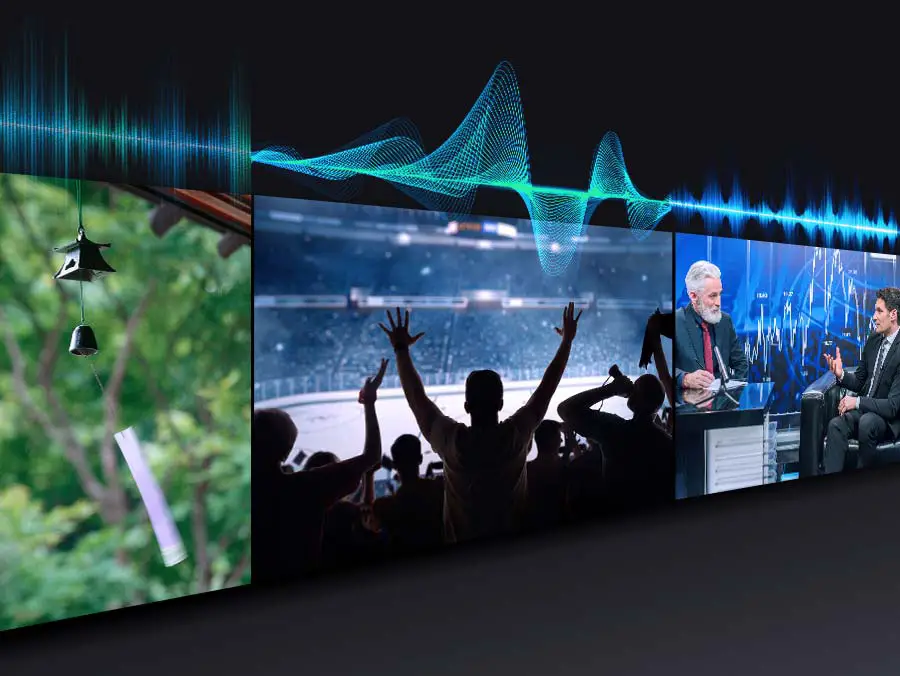
And obviously with a Samsung TV we could not miss Q-Symphony. This is a feature that you can use to combine the TVs audio system with an appropriate soundbar that supports it.
Samsung released a whole lineup of soundbars that support this feature in case you are thinking of getting one.
Overall Audio Performance Impressions
The TV is great for casual viewing. Sound is clear enough and can get loud with clarity in the dialog. Content like sports, news broadcasting and shows will behave nicely.
But if you want a cinematic experience then make yourself a favor and buy at least a decent soundbar. It will perform much better than the CU7000 will ever do.
Ports and Connectivity
Next we will be looking at what connectivity options we get here.
Starting from the top right we find the power connector, a single USB port, a digital optical audio output, three HDMI ports and the usual antenna/cable connector. There is also an Ethernet port which looks backwards for connecting the TV to your local network.
HDMI Specifications
Nothing has changed here and the CU7000, being a low tier offering comes only with HDMI 2.0 ports. This means that you do not get any of the gaming centric features these have.
At least we do get eARC which allows you to pass audio to an external sound system.
Connectivity Observations
Two observations here. First the Ethernet port is still the usual 100Mbps one. Let’s hope this will change at some point in the future.
And secondly the USB port is the older 2.0. Don’t expect to get a USB 3.0 when even top tier TVs still use this archaic version.
Wireless Capabilities
When it comes to its wireless capabilities the TV supports WiFi5 (802.11ac) along with Bluetooth 5.2 which is the same across all Samsung TVs in 2023.
OS, Apps and Features
Samsung updated their OS to the latest 2023 version but this is only a minor upgrade compared to the 2022 release. Almost everything is still the same and this year there are small improvements and additions.
The only difference is that the CU7000 uses a somewhat less capable version of the Tizen 2023 with reduced features. It still has much of the same functionality and design but there are some minor differences.

Tizen 2023
Being a Samsung TV means that for its OS we find the usual Tizen platform in its 2023 edition. The new Tizen occupies the whole screen instead of being a tile based row at the bottom of the screen, exactly as Google TV and webOS are lately.
It seems that smart TV platforms opt for a more personalized experience and as such the new OS tries to provide you with options that are tailored for your viewing habits. As such you will see personalized ads, recommendations for streaming services and broadcasting channels and even shopping suggestions.
If you have used Tizen before 2022, the new version may feel a bit chaotic at first. This was the same with Google TV and webOS when they changed into a full screen UI and certainly you will need to spend some time with it to get your bearings. But once you get the hung of it, it is easier to navigate than it may seem.
Samsung Smart TV Hub
The new Samsung Smart TV Hub includes different sections and it allows you to navigate easily through all of them. At the left of the screen there is a single column with a few central selections while the rest of the screen use rows with streaming services, apps and other functions and features available.
The new Tizen is not all that different really. Obviously the layout is tailored to Samsung’s needs but in essence it offers the same thing. Navigation was smooth enough and jumping from one app to the other was relatively fast and with no obvious lags or delays.
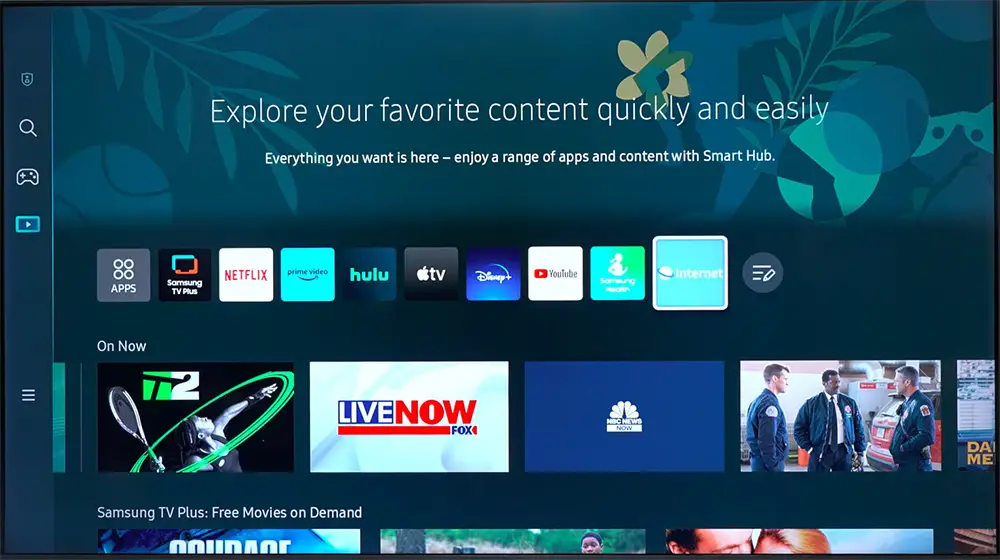
Streaming Capabilities
When it comes to content the Tizen platform is famous for it’s enormous support from developers. The TV supports practically all known services and platforms you can think of. Netflix, Apple TV, Disney Plus, Youtube, Amazon, Hulu, Rakuten, Demand 5 and BBC iPlayer are just a few of the big names available.
There is also Samsung TV plus which offers hundreds of subscription-free channels to choose from. Many of these services can playback in both 4K with HDR like Netflix and Amazon but this really depends on each app and not on the TV itself.
SmartThings Integration
With a Samsung TV SmartThings integration is a must. With it you can make your TV the central hub of all your smart house devices. These can be lights, electronic locks, alarms, vacuum robots, thermostats and everything that supports the SmartThings platform.
For 2023 Samsung added Matter and Thread integration meaning you can control such devices from a single app instead of multiple ones and there is no need for an additional dongle as it is built-in the TV itself.
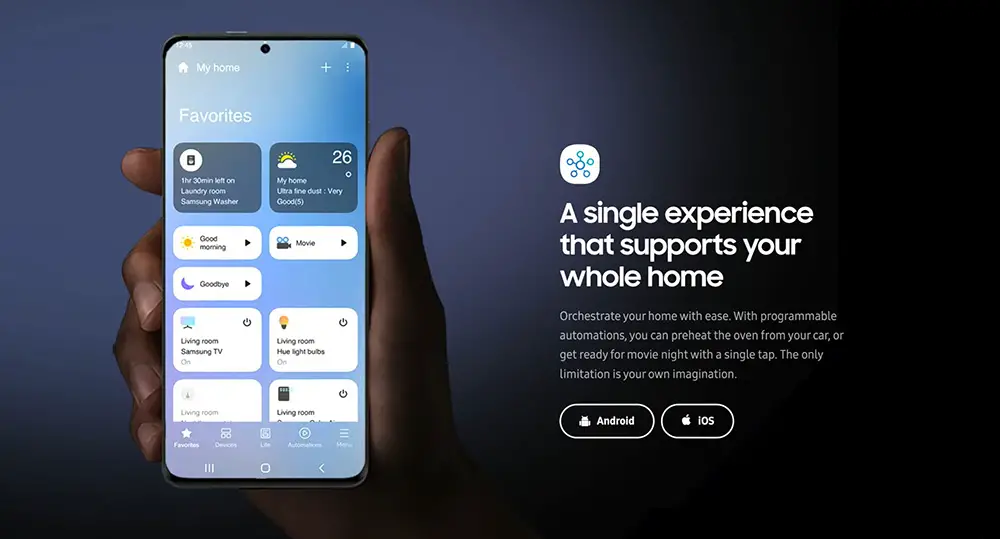
Voice Control
Voice control is another standard feature nowadays. But the difference here is that the CU7000 does not have this built-in. As a result you will need to use an external voice control device like a Google Nest to control the TV through voice.
The TV can work with both Amazon Alexa and Google Assistant voice control devices.
Unfortunately there is no Airplay support in this one. And as a result you cannot use Siri to control the TV either. Surely if you are an Apple guy this is not the TV you should go for if voice control is your thing.
Multi-View & Tap-View
The CU7000 is the only model that does not include Multi-View as this becomes available only in the CU8000 and above.
What we do get is Tap View. With it you can mirror your phone on your TV with just a tap to continue enjoying movies, music, and apps on the bigger screen within seconds. Nothing major, but anything that can save even a few seconds of your time can be valuable.
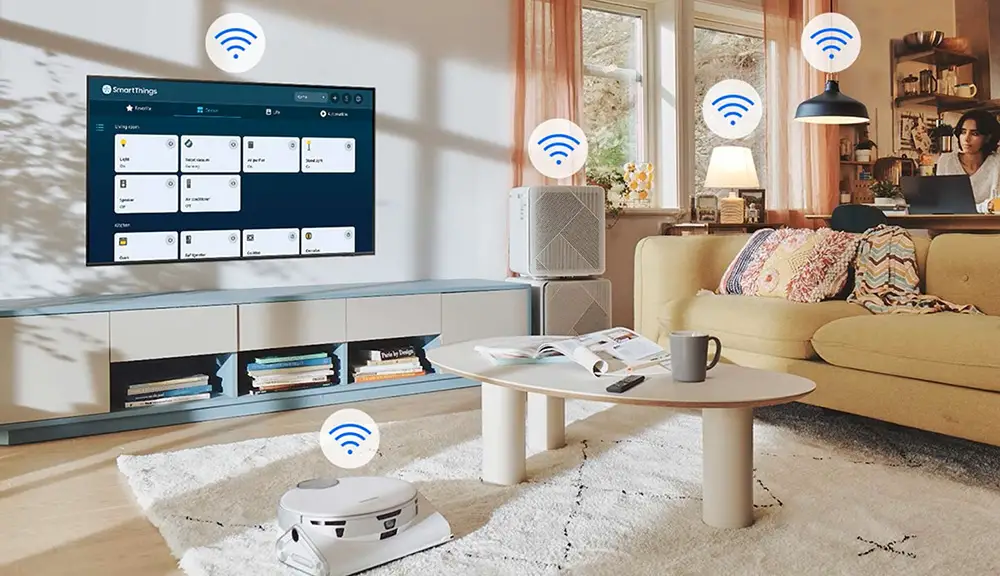
Ambient Mode
The TV is missing this feature completely.
Samsung Health
Samsung Health is another standard feature by now. The last couple of years, with the coronavirus pandemic, many people were staying indoors so Samsung thought that exercise at home would be on the rise. So many of their TVs came with Samsung’s program in order to stay in shape. It seems that Samsung liked it so they decided to keep it.
Various Other Features
Two more features that we get is the camera experience and workspace. With camera experience you can connect an external USB camera for online chatting. Workspace on the other hand lets you connect to various applications like Microsoft ones.
Compared to other TVs
Its performance is not all that different from previous Crystal TVs we had seen. All these Crystal models have small differences in terms of picture quality making them pretty equal.
As for other brands the one that comes in mind offering better performance at an almost similar price is the Hisense U6H.

Final Thoughts
The Crystal series CU7000 is your typical budget friendly TV that is perfect for any casual use. If you are looking for a TV that can do the basics but offer some extra features and smart functionality with the least cost possible then this is definitely a good choice.
Its up-scaling capabilities are good, it has very low input lag and the Tizen platform offers a lot of flexibility. For a dirty cheap gaming setup we cannot find anything bad to say about this. And surely many will choose this one for this exact reason.
On the other hand its SDR and HDR brightness were poor, its viewing angles mediocre, its color coverage and accuracy average and its motion performance problematic. Its Edge LED system without local dimming creates a washed out image in certain dark content while the TV is missing features like Dolby Atmos, Dolby Vision, DTS and HDMI 2.1.
The Samsung CU7000 is obviously a model of limited capabilities. There are other brands, like Hisense, that offer more value in this price range but if you prefer a low cost Samsung TV then the CU7000 can satisfy your needs, if you keep your expectations at check. And your wallet will surely be very pleased with such a choice.
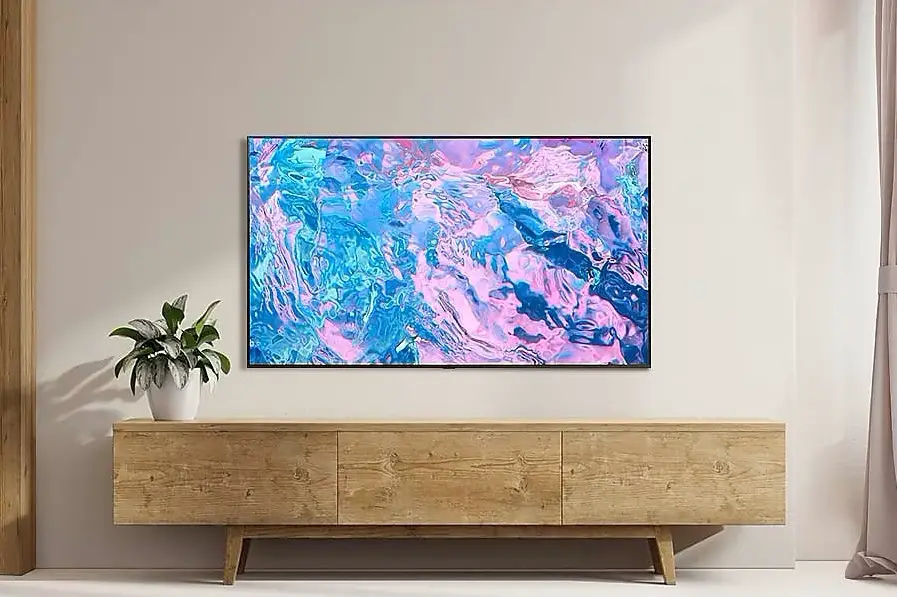
For more reviews you can check our dedicated 4K LED LCD TV reviews list or even look at our Product Reviews Table where you can find the brand and specific product you are looking for.
Cheapest Places to Buy :
*We are a reader-supported website. When you buy through links on our site, we may earn a small affiliate commission at no extra cost to you. Home Media Entertainment does not accept money for reviews.*
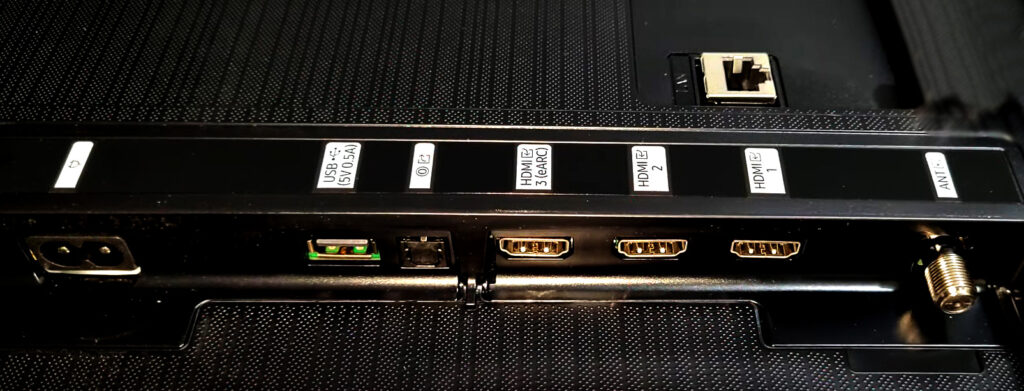
I had recently seen the CU7000 is a shop and I was not so much impressed by it. I get it, it is not supposed to be a TV that impresses but I was waiting for something a bit better. But as you say you need a dirty cheap TV with basic functions then why not? Especially if you are afraid to go for a brand like Hisense that doesn’t have such a stellar reputation like Samsung.
I think Samsung knows the power of their brand and that is why they are not afraid of the competition in the lower tiers. Hisense is definitely the performance king here but I have seen a lot of people a bit afraid to go that route. And I think Samsung knows it. But Hisense has improved a lot the last few years and if they continue the same route I see them challenging Samsung’s dominance pretty soon.
I hate Samsung’s cheap TVs. They are overpriced and there are far better choices out there. Samsung may be good at the top tiers but their budget TVs cannot go against competition. They just rely on their name and promotion prowess. That’s all. Great review by the way. Keep up the good work!
Hey Ammari. Thank you for the comment. Indeed competition is fierce in this price range and Samsung cannot rely on their brand recognition for ever. People will look for the best thing for their money and they have to step up their game in the lower categories.